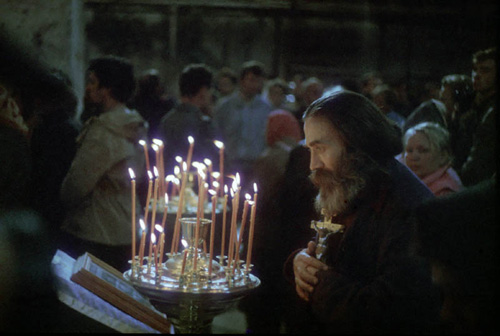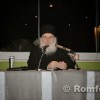Source: http://www.stgeorgegreenville.org
Standing versus Sitting
The traditional posture for prayer and worship in the Orthodox Church has been to stand. In the Orthodox “old countries” there usually are no pews in the churches. Chairs or benches on the side walls are usually reserved for the elderly and the infirm. In North America, we have tended to build our churches with pews.
It is fully acceptable (and even preferable) to stand for the entire service. If you prefer this it would be better to find a place closer to the back or side of the temple so as not to stand out or block someone’s view.
When should you definitely stand? Always stand during the Gospel reading, the Little and Great Entrances, the Anaphora, the distribution of Communion, the special services for a Memorial or the Artoklasia, whenever the priest gives a blessing, at the dismissal.

Entering the Cathedral (Late!)
The time to arrive at the Cathedral is before a service starts. For some unknown reason, however, it has become a bad habit for some individuals and families to come late. If you arrive after a service begins, try to enter the nave of the Cathedral quietly and observe what is happening. If a scripture selection is being read, or an entrance is taking place, or during the Anaphora and Consecration, wait until it is finished to find a seat. If the celebrant is delivering a sermon, stay in the back of the nave or narthex until he has finished. If in doubt, check with one of the ushers to see if it is a good time to seat yourself. Try not to interrupt a service by your entrance.
By the way, the best way to avoid the problem is to arrive on time – then you do not have to wonder whether it is appropriate to enter or not. To partake of the Eucharist correctly you should be there for the entire Liturgy.
Crossing Legs
In some Orthodox cultures, crossing one’s legs is taboo and considered to be very disrespectful. In our North American there are no real taboos concerning crossing one’s legs, and we tend to do so to get comfortable when sitting. Should we cross our legs in the Cathedral during services? No. Not because it is wrong to ever cross your legs, but because it is too casual, and too relaxed, for being in the Cathedral. Just think about it, when you get settled into your favorite chair at home, you lean back, cross your legs, and then your mind can wander anywhere it wants to.
Remember, sitting in the nave is a concession to human weakness; not the normative posture for prayer. Crossing your legs is an even further surrender to laxity. You surely do not want to get too relaxed and let your mind wander off too much. In fact, when you sit in the Cathedral, sit attentively – and not too comfortably. When sitting in the Cathedral, keep your feet flat on the floor, ready to stand at attention (which, after all, is precisely what “Let us be attentive!” means).
The general rule is, cross yourself with your fingers and hand – but do not cross your legs!
In and Out
In and out should not characterize the traffic pattern through our Cathedral during services. It sometimes seems that our churches must have a revolving door at the entrance; it is used by both children and adults. Use the restroom before coming to the nave; or immediately upon arrival if your journey was lengthy. You should not need to get a drink of water during the services – especially if you plan to receive Communion. Do not come to the church in order to go to the fellowship hall; come to pray.
Leaving Before the Dismissal
Leaving the Cathedral before the Dismissal is not only rude, but it deprives us of a blessing. Worship has a beginning (“Blessed is our God” or “Blessed is the Kingdom”) and an ending (“Through the prayers of our holy fathers”.) To leave immediately after receiving Holy Communion is to treat the Cathedral like a fast food restaurant where we come and go as we please. We live in a fast paced world where we seem to be hurrying from place to place. But in God’s presence we need to make every attempt to light this pressure to move on to the next thing on the day’s agenda. When we ultimately get to the Kingdom of Heaven there will be no follow-on agenda; likewise when we arrive and hear the words, “Blessed is the Kingdom . . .” we should be glad to sojourn in the presence of God’s house.
We deprive ourselves of blessings by not being still and participating in God’s holiness. Eat and run at fast food places – but stay in the Cathedral to partake of God’s precious gifts and to thank Him for them.
Blot that Lipstick
Have you ever looked at an icon in just the right light and have seen the lip prints all over? It’s distracting, isn’t it? Lipstick may arguably look fine on lips, but not on icons, crosses, the Communion spoon, and the Bishop’s or Priest’s hand. Icons have been ruined by lipstick; and it is at the very least inconsiderate of others to leave your lipstick behind for them to have to deal with.
Venerating Icons
When you enter the Cathedral it is customary to venerate the holy icons. There are icons in the narthex. Newcomers to the Church are often confused or perplexed about venerating icons. It is customary when venerating an icon to make two reverences (sign of the cross followed by a bow), sign of the cross a third time followed by kissing the icon, then a final reverence (sign of the cross followed by a bow).
When venerating (kissing) an icon, pay attention to where you kiss. It is not proper to kiss an icon on the face; after all, you wouldn’t go up and kiss the Lord or His Mother on the lips, would you? Rather, you would kiss their hand. Pay attention to what you are doing. When you approach an icon to venerate it, kiss the Gospel, scroll, or hand cross in the hand of the person depicted, or kiss the hand or foot. In fact, the hands and feet on some icons are covered with metal for just this purpose and so as not to damage the icon itself.
As you venerate an icon, show the proper respect due to the person depicted; the same respect you would show them in person. Remember blot off that lipstick first!
Talking During Church
Isn’t it great to come to the Cathredal and see friends and family members? But wait until the coffee hour to say “Hi” to them. It just is not appropriate to greet people and have a conversation with them during the services. Besides being disrespectful towards God, it is rude towards the other people in the Cathedral who are trying to worship. Talk to God while in the church through your prayers, hymns, and thanksgiving – and to your friends in the fellowship hall afterwards.
Kiss (Don’t shake) the Bishop’s and Priest’s Hand
Did you know that the proper way to greet a bishop or priest is to ask his blessing and kiss his right hand? How do you do this? Traditionally, one approaches the bishop or priest with the right hand over the left hand and says, “Master (if a bishop, or ‘Father’ if a priest), bless.” In the Byzantine tradition in this country, the faithful usually take the bishop’s or priest’s right hand as though to shake it, but instead kiss it.
It is not appropriate to merely shake the hand of the bishop or priest, because, after all, they are not “just one of the boys.” When you kiss their hands, just as when you kiss an icon, you show reverence and respect for their holy office which is to be an iconographic icon of Christ, the one High Priest. Moreover, they are the ones who bless and sanctify you, and who offer the Holy Gifts on your behalf in the Divine Liturgy. So, the next time you greet your bishop or priest, do not shake his hand, ask for his blessing.
Sunday Dress
Remember the time when people put on their “Sunday best” to go to church? In fact, dress clothes were often referred to as ‘Sunday clothes.” This is not all that common today; in fact all too often the dress in our churches has become too casual. In all the areas of our lives, we should offer Christ our best; and the same is true of our dress. We should offer Christ our “Sunday best,” not our everyday or common wear. And we should dress modestly, not in a flashy way that would bring attention to ourselves – and certainly not in a provocative or alluring way. Our dress should always be becoming to a Christian – especially in the temple.
Here are some general guidelines:
Children: Only young children (under 10) should wear shorts to the services – and then only dress shorts. Athletic shoes, cut-offs, spandex shorts, etc., are never appropriate for wear in the temple (for children or adults!). Shoes or sandals should be clean and tied. No one should wear a T-shirt with any kind of writing on it.
Women: Dresses should be modest. No tank tops (or dresses with only straps at the shoulders), no short skirts (mini-skirts), and no skin-tight dresses. Dresses should have backs and should not be low-cut in the front. Though it is not customary for women to wear pants to church, if women do wear pants to the services, they should be dress pants (not jeans or leggings). Shorts of any type are inappropriate.
Men: Men should also dress modestly. Coats and ties are not mandatory, but certainly always appropriate. Shirts should have collars and be buttoned to the collar (the actual collar button may be undone, but two or three buttons undone is inappropriate). Trousers should be clean. Blue (or black, or green, etc.) jeans are usually too casual for wear at the services (especially those with patches or holes). Again, shorts of any type are inappropriate.
If you are going someplace after the services where you need to dress casually, bring a change of clothing with you and change after the fellowship hour. Remember to use your best judgment and good taste when dressing for the services. After all, you do not need to be seen by everyone else – you go to meet and worship God.
Pew Blocking
Never heard of pew blocking? It is the practice of sitting right next to the aisle so that no one else can get by or sit in the middle of the pew. Everyone has seen it. In fact, the best pew blockers come early so that they can get the coveted aisle seats and then be sure no one can get past them. The most effective form of pew blocking, takes place when two people take their places on opposite ends of the same pew, thus effectively eliminating anyone else from sitting in that row.
There are two solutions to pew blocking. The first is simply to move towards tile middle of the pew, leaving the aisle seats for those coming later. For those of you who cannot handle sitting in the middle of the pew, take the outside aisle spot and graciously allow those coming after you to go past you (even by moving out so they can get by). Remember, pew blocking is not hospitable – nor is it an efficient system of seating. So don’t be selfish; move on over towards the middle. Don’t be a pew blocker.
To Cross or not to Cross
Anyone who has looked around during the services will notice that different people cross themselves at different times (and sometimes even in different ways). To a certain extent, when “to cross” oneself is according to personal piety, and not an issue of dogma. But there are times when it is specifically proper to cross yourself and times when you should not. Here is a brief list of when to cross and when not to cross.
To Cross: When you hear one of the variations of the phrase “Father, Son, and Holy Spirit” at the beginning and end of the services and your private prayers; before venerating an icon, the cross, or the Gospel book; upon entering or exiting the Cathedral; when passing in front of the holy Altar Table.
Not to Cross: At the chalice before or after taking Communion (you might hit the chalice with your hand).
Snacks for Children
You can always tell where the young children have been sitting in the Cathedral. The telltale signs are graham cracker crumbs, cheerios, and animal crackers. Parents sometimes bring snacks or juice along for children during the services. Such activity is disrespectful of the sacred services and disruptive to others in attendance.
At the very most, a bottle may be brought for very small children and babies. Eating snacks (or even whole meals) is totally inappropriate. If a child has an immediate need for nourishment, they should be fed before the services, or taken outside the Cathedral to eat a snack.
If a child did eat something during the service, parents should clean up any mess before leaving the pew.
Children who are going to receive Holy Communion should learn to fast Sunday mornings by the age of seven.
By the way, chewing gum is a NO-NO during Liturgy for everyone.
Handling the Antidoron
After receiving Communion, and also at the end of the Divine Liturgy it is customary to receive a piece of Antidoron – the bread that was left over when the Holy Gifts were prepared prior to the Liturgy. While Antidoron is not Communion – the Body of Christ – it is nonetheless blessed and should therefore be eaten carefully so that crumbs do not fall all over the place. After receiving Holy Communion, take one piece of Antidoron (you do not need four or five pieces) and when you return to your seat – or get to a place where you can stop for a moment – eat the bread trying not to drop any crumbs.
If you wish to bring a piece to someone else, take an extra piece – do not break yours in half because it produces too many crumbs. And monitor your children as they take Antidoron and teach them to eat it respectfully
A Final Thought
North American society in the late 20th century is rather casual in its approach to life. Do not allow this prevailing attitude to enter into your Orthodox Christian piety.
There are surely a lot of other areas that could be covered here, but keep in mind that most of Church etiquette is based on common sense and on showing respect for God and others.
Always remember that you are in the Cathedral to worship God, the Holy Trinity.
The priest proclaims, “With fear of God, faith and love, draw near;” let this be the way you approach all of worship. If you do, you will probably have good Church etiquette.
(Editor’s Note: The above is adapted from an article was printed at the direction of His Grace, Bishop Isaiah of Denver, who offered it to the faithful of his Diocese for their guidance. It was first printed in Word magazine, the official publication of the Antiochian Orthodox Christian Archdiocese of New York and all North America. It was subsequently reprinted in The Diocesan Observer, the official publication of the Serbian Orthodox New Gracanica Metropolitanate-Diocese of America and Canada The author is Father David Barr, Pastor of Holy Resurrection Church in Tucson, Arizona, a parish of the Antiochian Archdiocese.)
















